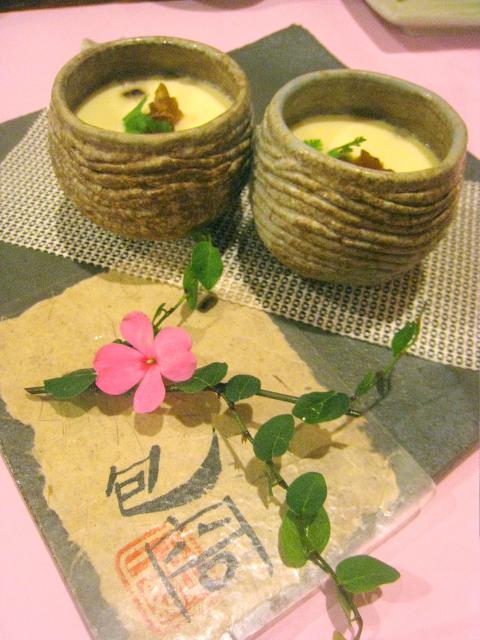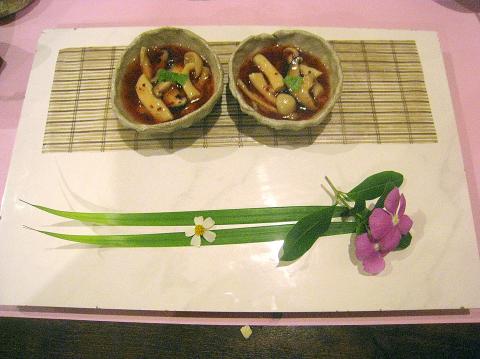Hidden on a back road in Luodong Township (羅東) in Yilan County, Guest City (客人城) is nothing like its English name suggests. Instead of a big, flashy facade and a lengthy menu promising everything land and sea have to offer, the establishment is a traditional, rather conservative farmer’s house and the menu is wholly at the discretion of the proprietor. Set menus weigh in at between NT$400 and NT$500 for a 10-course meal. The menu changes seasonally, with minor variations for product availability. The design of the menu is under the control of Chen Kuo-chang (陳國章), an artist and former veterinary surgeon who has been running this center of artisanal food for over a decade.
The dishes served at Guest City are what Chen feels are right for the moment. As the food arrives, he does a round of the tables in the rustic cotton pajama outfit of a farmer, sans footwear. He is more than happy to go into considerable detail about the food, as many of the materials and condiments are either homegrown, or at least prepared using local ingredients.
The style of the food is modern Taiwanese, and the presentation is designer rustic. All the crockery and some of the utensils are the handmade creations of the proprietor, including both rough terra-cotta ware and some found art (one of the serving platters used was a commercially produced tile that had been slightly embellished). There is much to admire in the presentation. The food was mostly good to excellent over the 10 courses, with a few minor blips, but there was always something to keep it interesting.

Photo: Ian Bartholomew, Taipei Times
Chen preaches a return to old-style culinary values. He makes a wide range of vinegars that are used to dress some of the dishes, produces his own sun-dried radish (untouched by any chemicals) and even makes his own sausages and cured meats. The portions are small, focusing attention on the individual ingredients.
A tiny bowl of crisp, raw pumpkin marinated in homemade vinegar had remarkably vibrant flavors. A small mound of seasonal vegetables, blanched and lightly dressed, was extremely delicate. A lightly stewed bowl of three types of mushroom forced one to contemplate the relationship between texture and flavor.
A small dish of asparagus tips was spoilt by a squeeze of what was clearly commercially produced mayonnaise. The vegetable itself was soft with a slight crispness, but the provenience of the mayo spoiled the purity of the overall presentation. This was just a tiny misstep — a thoughtless following of a popular Taiwanese culinary practice.

Photo: Ian Bartholomew, Taipei Times
A selection of cold meats, served on a taro leaf, was interesting. The quality of the meat was good and a side of lightly pickled cucumber set it off nicely. A very fine steamed egg and a dark soup of pork and dried radish each showed considerable character. Most of the dishes are served in small bowls, and bulk is provided by steamed rice mixed with lard, another rustic staple that is coming back into fashion.
The care and commitment that has gone into the creation of the dining experience is very much apparent at Guest City, but for some, the food might be a trifle bland. Care and attention is needed to appreciate the refinement of the preparation, but sometimes the flavors are simply not big enough to make an impression. All of this can make the dining experience at Guest City ever so slightly anemic, especially for those who favor rich flavors and hearty portions. For the health conscious, or for those who want to taste the terroir of Yilan through its natural produce and its traditional culinary practices, Guest City will provide a most interesting experience.

In the March 9 edition of the Taipei Times a piece by Ninon Godefroy ran with the headine “The quiet, gentle rhythm of Taiwan.” It started with the line “Taiwan is a small, humble place. There is no Eiffel Tower, no pyramids — no singular attraction that draws the world’s attention.” I laughed out loud at that. This was out of no disrespect for the author or the piece, which made some interesting analogies and good points about how both Din Tai Fung’s and Taiwan Semiconductor Manufacturing Co’s (TSMC, 台積電) meticulous attention to detail and quality are not quite up to

April 21 to April 27 Hsieh Er’s (謝娥) political fortunes were rising fast after she got out of jail and joined the Chinese Nationalist Party (KMT) in December 1945. Not only did she hold key positions in various committees, she was elected the only woman on the Taipei City Council and headed to Nanjing in 1946 as the sole Taiwanese female representative to the National Constituent Assembly. With the support of first lady Soong May-ling (宋美齡), she started the Taipei Women’s Association and Taiwan Provincial Women’s Association, where she

Chinese Nationalist Party (KMT) Chairman Eric Chu (朱立倫) hatched a bold plan to charge forward and seize the initiative when he held a protest in front of the Taipei City Prosecutors’ Office. Though risky, because illegal, its success would help tackle at least six problems facing both himself and the KMT. What he did not see coming was Taipei Mayor Chiang Wan-an (將萬安) tripping him up out of the gate. In spite of Chu being the most consequential and successful KMT chairman since the early 2010s — arguably saving the party from financial ruin and restoring its electoral viability —

It is one of the more remarkable facts of Taiwan history that it was never occupied or claimed by any of the numerous kingdoms of southern China — Han or otherwise — that lay just across the water from it. None of their brilliant ministers ever discovered that Taiwan was a “core interest” of the state whose annexation was “inevitable.” As Paul Kua notes in an excellent monograph laying out how the Portuguese gave Taiwan the name “Formosa,” the first Europeans to express an interest in occupying Taiwan were the Spanish. Tonio Andrade in his seminal work, How Taiwan Became Chinese,